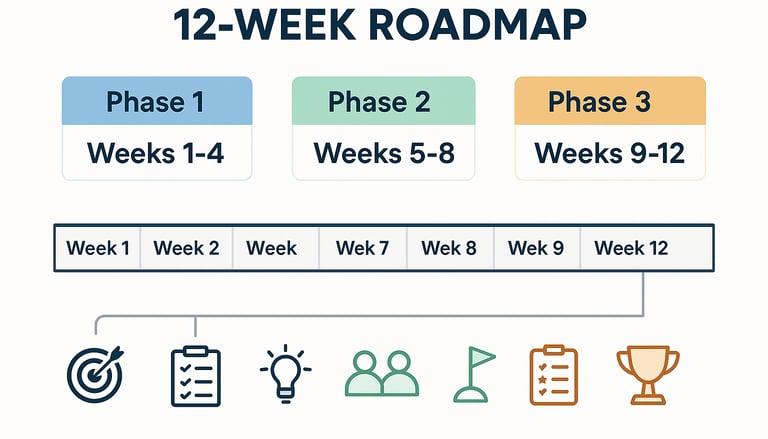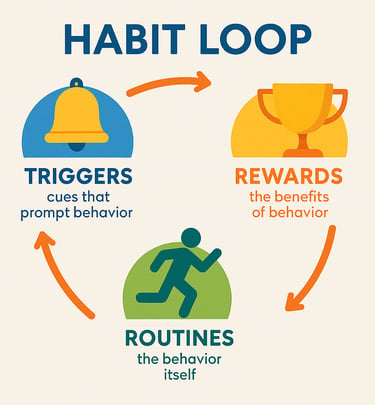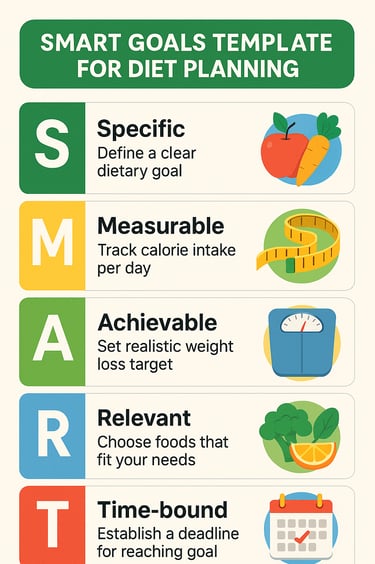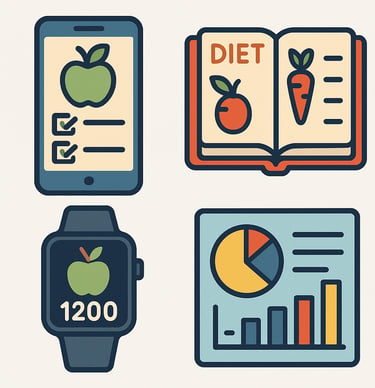"How to Set Diet Goals That Actually Work: 5-Step Formula [2025 Guide]"
"Why 95% of diet goals fail + 5-step formula that works: Set realistic targets, track progress, and reach your ideal weight without giving up foods you love."
HEALTH TIPS


Understanding the Habit Loop: Triggers, Routines & Rewards
Transforming eating patterns begins with decoding the habit loop, a three-step cycle that automates behavior:
Trigger: The cue that sparks action—this could be an emotion (stress, boredom) or an
external signal (food ads, social events).
Routine: The behavior itself, such as reaching for a sugary snack when anxious.
Reward: The payoff—comfort, stress relief or pleasure—that reinforces the loop.
By mapping your personal triggers and rewards, you can consciously replace unhelpful routines (e.g., stress-eating chips) with
healthier responses (e.g., a brief walk or herbal tea).
Cultivating a Growth Mindset for Sustainable Change
A growth mindset empowers you to regard setbacks as learning opportunities rather than failures. Key strategies include:
Self-Efficacy Boosters: Celebrate small wins—each successful healthy choice strengthens your confidence to tackle tougher goals.
Mental Rehearsal: Visualize choosing veggies instead of fries when trigger situations arise.
Resilience Drills: When you slip up, analyze the cause, adjust your plan, and recommit immediately.
SMART Goals: Blueprint for Clear, Achievable Diet Milestones
Applying the SMART framework turns vague intentions into action plans:
Specific: “Eat five servings of vegetables daily” rather than “eat healthier.”
Measurable: Track servings, calories or meal prep sessions in a journal or app.
Achievable: Set realistic targets—losing 1–2 pounds per week or cooking three home-made lunches each week.
Relevant: Ensure goals align with personal values, such as reducing inflammation or increasing energy.
Time-Bound: Give yourself deadlines, e.g., “Complete eight weeks of meal prep by December 1st.”
Example SMART Goal:
“I will prepare and consume five servings of colorful vegetables per day for the next six weeks, logging each meal in a nutrition app.”
Crafting a 12-Week Roadmap: Macro to Micro Planning
Divide your long-term vision into manageable phases:
Weeks 1–4: Foundation—establish meal prep routines and basic grocery planning.
Weeks 5–8: Optimization—fine-tune portion sizes, experiment with new healthy recipes, and adjust for seasonal produce.
Weeks 9–12: Maintenance—focus on consistency, introduce intermittent fasting or time-restricted eating, and solidify social support habits.
At the end of each phase, review outcomes, celebrate progress, and tweak strategies to overcome obstacles.
Weekly Planning Script: Streamlining Your Meal Prep
Dedicate one day per week to:
Menu Selection: Choose balanced recipes covering proteins, whole grains, healthy fats and plenty of produce.
Grocery Organization: List ingredients by section (produce, proteins, grains) to speed shopping and curb impulse buys.
Batch Cooking: Pre-cook staples—grains, lean proteins and roasted vegetables. Portion into containers for grab-and-go meals.
This script prevents last-minute decisions and keeps you aligned with your dietary goals.
Tracking Progress: Selecting the Right Tools
Monitoring intake and habits drives accountability and insight:
Apps: MyFitnessPal or Cronometer for calorie and macronutrient logging.
Paper Journals: For mindful reflection on meals, moods and triggers.
Wearables: Track activity, sleep and stress metrics to correlate lifestyle factors with eating patterns.
Choose tools that integrate seamlessly with your routine to ensure long-term adherence.
Learning from Setbacks: Six Recovery Strategies
Overindulgence: Don’t punish yourself. Return to your plan at the next meal and view one slip as data, not defeat.
Social Pressure: Eat a healthy snack beforehand and politely decline or share smaller portions.
Emotional Eating: Identify your trigger, then substitute a coping strategy—deep breathing, journaling or a brisk walk.
Weight Plateau: Reevaluate portions or tweak macronutrient balance. Introduce new workouts to boost metabolism.
Travel Challenges: Pack protein bars, nuts or pre-cut veggies. Scout healthy restaurant options in advance.
Motivation Lull: Revisit your “why,” set mini-goals for quick wins, and enlist an accountability buddy.
FAQs: Quick Answers for Common Roadblocks
Q: How do I curb cravings naturally?
A: Stay hydrated, prioritize balanced meals (protein + fiber + healthy fats), and allow small treats in moderation.
Q: Is it okay to adjust my SMART goal mid-course?
A: Absolutely—relevance and achievability may change as you progress. Reassess and refine rather than abandon your plan.
Q: What’s the best way to measure success?
A: Track behavior metrics (meal prep sessions, servings of produce) over scale metrics. Small habit wins compound into big health gains.
Resources for Deeper Learning
Atomic Habits by James Clear: Practical tactics on building and reshaping habits.
The Power of Habit by Charles Duhigg: Insight into the neuroscience of habit loops.
The Happiness Lab podcast: Strategies for sustainable behavior change.
American Psychological Association: Articles on behavior-change techniques.
By weaving together psychology, planning frameworks and real-world tools, you can break free from old patterns and build sustainable, health-supporting habits. Implement these strategies, adapt them to your lifestyle, and watch as small, consistent changes transform your diet and well-being.






Connect
Stay updated with our latest diet tips.
Legal
www.thedietplanner.com © 2025. All rights reserved.